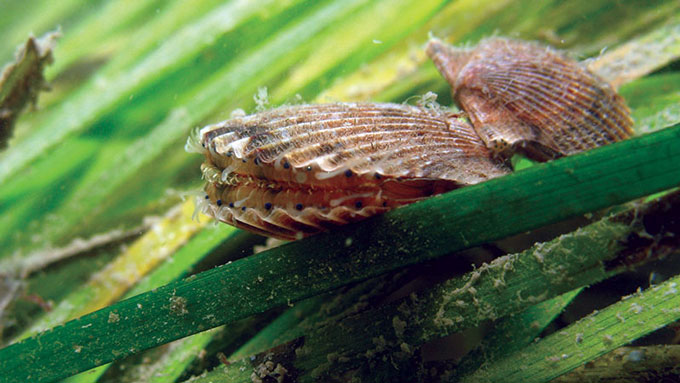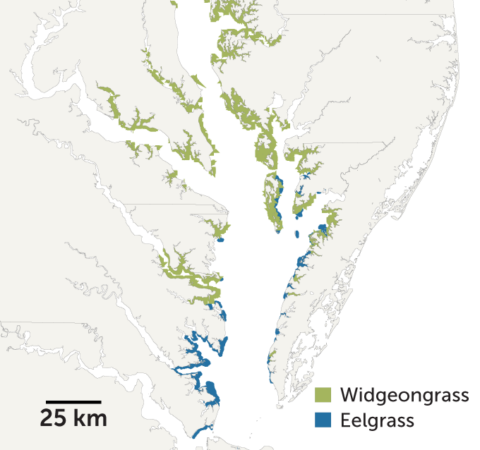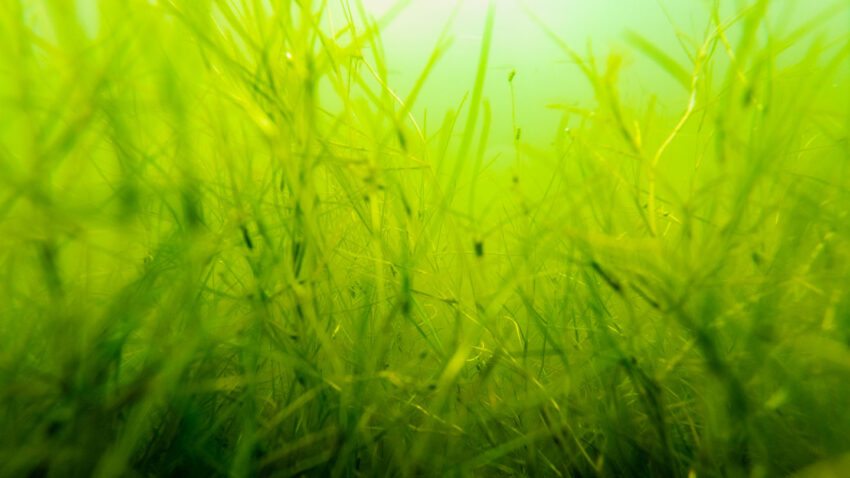On the U.S. mid-Atlantic seaboard, efforts to restore the health of the Chesapeake Bay over the last 10 years have faced a mysterious challenge — massive booms and busts of the seagrass meadows that provide crucial habitats for juvenile blue crabs, black sea bass and scores of other creatures. Now researchers have uncovered the surprising reasons for these dramatic swings.

A weedy plant that used to lurk only at low levels in the Bay is becoming dominant, dethroning the Bay’s historically predominant eelgrass, says ecologist Chris Patrick of the Virginia Institute of Marine Sciences in Gloucester Point. Widgeongrass’s ability to grow like, well, a weed has caused the Bay’s seagrass meadow to nearly triple in extent, Patrick and colleagues report May 30 in the Proceedings of the National Academy of Sciences. That was a “big shock to everyone,” he says. But widgeongrass is also more vulnerable than eelgrass to sunlight-blocking water pollution, making it prone to huge crashes.
These findings offer “a weird message of hope,” says VIMS ecologist Marc Hensel. Understanding the ecology of shifting seagrasses offers solutions to better protecting and restoring sea meadows, not just in the Chesapeake Bay but also for many other estuaries and coastal ecosystems.
The study combines aerial surveys of 26,000 hectares of habitat with 40 years of data on nutrient and sediment pollution, seagrass coverage, temperatures, plankton blooms and river flows. These data provide “an almost unprecedented record of submerged aquatic vegetation,” says ecologist and seagrass expert Emmett Duffy of the Smithsonian Environmental Research Center in Edgewater, Md., who was not involved in the study. Particularly important is the researchers’ ability to distinguish between seagrass species, he says.
Where’s the seagrass?
In 2019, eelgrass (blue) was the dominant seagrass in the southern parts of Chesapeake Bay (shown in this map), but it once thrived throughout the region. Many of those regions, predominately in the north, are now dominated by widgeongrass (green), which has been expanding rapidly as warming water temperatures shift the seagrass ecosystem.
Chesapeake Bay seagrass meadow coverage in 2019

The extent of the Bay’s eelgrass (Zostera marina) has plunged by more than half since 1991, the team found, despite successful efforts to restore it in some spots (SN: 10/14/20). Higher water temperatures caused by climate change starve the plant by jacking up its respiration rate to burn more food than can be supplied by photosynthesis.
Conventional ecological wisdom holds that a more heat-tolerant species migrating from warmer southern waters would replace eelgrass. Instead, the big winner for now is wimpy-looking widgeongrass (Ruppia maritima). With hardy seeds, rapid growth rates and an ability to thrive in water about 7 degrees Celsius warmer than the optimal highest temperature for eelgrass (about 20° C), “widgeongrass almost literally has been waiting in the shallows for its opportunity,” Hensel says.
Fueled largely by widgeongrass, the total area of seagrass meadows in the Bay leapt from just over 15,000 hectares in 1984 to a record peak of nearly 44,000 hectares in 2018. The very thin and branchy leaves of widgeongrass may offer a better habitat than the eelgrass for tiny crustaceans like amphipods and isopods, Patrick suggests. But with its wispy structure and shallower roots, widgeongrass doesn’t provide as much biomass, and thus carbon storage, or as good a habitat for crabs and fish as taller, more luxuriant eelgrass does, says Duffy, who has dubbed eelgrass the “Serengeti of the sea.”
To some extent though, widgeongrass “is making up for the loss of the eelgrass,” Duffy says. To the researchers struggling to restore the Bay’s vegetation, the expansion of widgeongrass qualifies as a win. “When environmental conditions change, species that were always there may step up, change their roles, and do something really positive for the Bay,” Patrick says.
Seagrass swings
Over the past four decades, warming temperatures have shifted the balance of seagrass species in Chesapeake Bay. Eelgrass (blue) has subsided while widgeongrass (green) has exploded. That surge drove total seagrass meadows (black) to nearly triple in area between 1984 and 2018. But in 2019, the meadows suffered the largest known crash when nutrient pollution wiped out about half of the widgeongrass.
These positives come with a big caution, though. Widgeongrass habitats are far less stable than their eelgrass predecessors. The largest recorded dieback of seagrass meadows in Chesapeake Bay history occurred in 2019, when half of the widgeongrass — about 9,000 hectares — vanished. Heavy springtime rains flushed massive amounts of nutrients and sediment into the Bay, causing algal blooms that blocked sunlight from reaching the plants’ short springtime leaves, the team found. The taller leaves of eelgrass, in contrast, reach closer to the surface, making that species less vulnerable to poor water quality conditions.
Similar shifts to more unstable and potentially less productive aquatic ecosystems are occurring all around the world, from Tampa Bay in Florida to the English Channel, as human influences and climate change enable weedy, more ephemeral plants to increase at the expense of the old growth, Duffy says. But the new study suggests that careful monitoring that identifies the individual species of plants, not just the total area of vegetation, then reducing the nutrient and sediment runoff reaching the most susceptible areas, may help mitigate the harm.
In the Chesapeake, that means targeting agricultural pollution flowing into the Bay from the Choptank River and in the Tangier Sound. While the new weedier species may not be as good as the original plants, “if we can get the right combination of environmental conditions, we can restore mature, functioning seagrass meadows in one or two decades,” Patrick says. “You can’t do that with any other ecosystem.”

